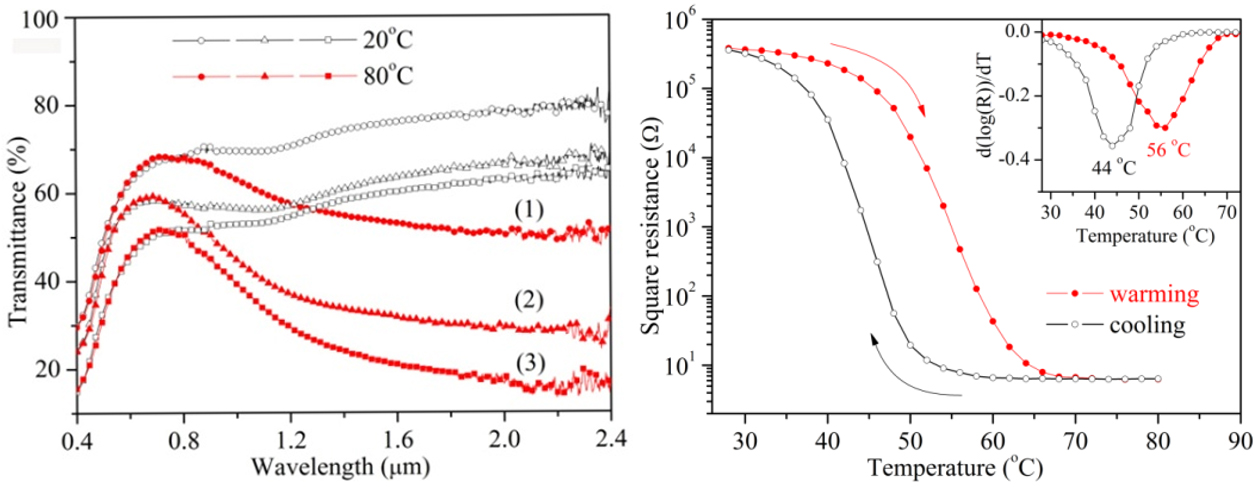Hefei Research Institute Makes Progress in the Research of Vanadium Dioxide Thermally Induced Phase Change Nanomaterials
Recently, researcher Li Guanghai, researcher at the Institute of Solid State Physics, Institute of Solid State Physics, Chinese Academy of Sciences, made progress in the research of M-phase VO2 (VO2(M)) thermally induced phase change nanomaterials. The relevant research work was published in the form of a back cover article on "Chem. A Euro. J. 22 (2016) 17627) and was granted a national invention patent (ZL201310384430.3).
VO2(M) nanomaterials have reversible metal-semiconductor phase transitions. Due to abrupt changes in the optical and electrical properties of the materials before and after phase transformation, they have important application prospects in the fields of optoelectronic devices, infrared detection, and smart windows. Therefore, the development of low-cost and controllable preparation technology is of great significance for realizing the industrialization and application of VO2(M) nanomaterials.
Dr. Li Guanghai, Ph.D., developed a method to directly prepare high-quality amorphous VO2 colloids using anodized metal vanadium. The obtained colloids not only have good dispersion, good film-forming properties, but also have high anti-oxidation capability. Amorphous VO2 colloids can be directly converted to VO2(M) nanoparticles by means of low-temperature, rapid heat treatment in air. The prepared VO2 (M) nanoparticle film has good thermochromic and thermistor properties, and the conductivity change before and after the phase change reaches the order of 5×10 4 , and the integral transmittance of sunlight and the integral transmittance of visible light can reach respectively. 9.4% and 40.7%. It is worth mentioning that the preparation of amorphous VO2 colloids sprayed on the preheated glass can be directly prepared VO2 (M) thermochromic film, laid a certain material basis for the scale of VO2 (M) preparation and practical application.
The research was funded by the National Natural Science Foundation of China (51372250 and 51402304).

Left: Transmission spectra of VO2 (M) nanoparticle films of different thickness: (1) 160 (2) 230 and (3) 420 nm. Right: VO2 (M) nanoparticle film sheet resistance-temperature curve.
Chemical Industry Mass Flow Meter
Sealand is a professional supplier of Chemical Mass Flow Meter, Chemical Mass Flowmeter, Chemical Flowmeter, Chemical Flow Meter, Chemical Coriolis Meter, ATEX, IECEx & CE approved.
The meter can work with a pulse receiver(Count). The connection is as follows. The resistance value is up to the cable length & the max. input pulse frequency of receiver. Current 10mA is suitable for most receivers; however, you can reduce the resistance value when the cable is long. The max. current could be 50mA. Please use the fixed frequency output function to check if the cable length & resistance value is suitable.
Please check following items before operation, and operate according to relevant rules.
a) If the meter is damaged during shipment and installation;
b) If the voltage is same as marked on nameplate;
c) If the fuse is correct;
d) If the meter is grounded properly.
e) If the Meter SN on the nameplate of sensor and transmitter are the same.
If everything is fine, please open all valves, make the pipeline full of liquid and then power on
the meter for warm-up for 20min before operation. Finally, conduct zero calibration after first
start, and shall do it again if the meter is moved to another site.
Preparation for zero calibration:
a) Power on the meter for approximately 20min for warm-up;
b) Run the process fluid through the sensor until the sensor temperature reaches the normal
process operating temperature.
c) Close the shutoff valve downstream from the sensor.
d) Ensure that the sensor is filled with fluid and the process flow has completely stopped.
Chemical Mass Flow Meter, Chemical Mass Flowmeter, Chemical Flowmeter, Chemical Flow Meter, Chemical Coriolis Meter
Zhejiang Sealand Technology Co., Ltd. , https://www.sealandflowmeters.com